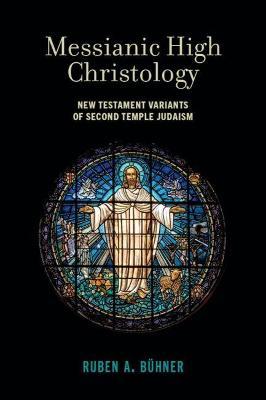Messianic High Christology: New Testament Variants of Second Temple Judaism

Messianic High Christology: New Testament Variants of Second Temple Judaism
The depiction of Christ as divine is often assumed to be the categorical difference between early Jewish messianism and New Testament Christology. Despite the prolific accomplishments of recent scholarship on Second Temple messianism and on the origin and development of "high" Christology, research has largely treated these as two separate lines of inquiry. As an unintended result, earliest Christianity appears not as an organic outgrowth of ancient Judaism, but as something of an anomaly. Ruben A. Bühner calls this line of thinking into question in Messianic High Christology.
Through a curated set of exegetical comparisons, each between a christological text and one or two messianic texts, Bühner reveals to what extent Second Temple messianism is indeed the primary context for the high Christologies of the New Testament: most New Testament concepts of Christ's divinity are to be understood precisely as part of contemporary discourse within early Jewish messianism. While early understandings of Christ are not simply identical with some other Jewish messianic expectations, they should be understood as deliberate developments in acceptance of and in dialogue with the wider Jewish discourse produced by some Jewish subgroups. As Bühner argues, it was not until the second and subsequent centuries that Jews as well as non-Jewish followers of Christ began to consider the divinity of the messiah as the decisive criterion by which to distinguish between what later would develop into two separate religions.
With Messianic High Christology, Bühner brings the New Testament Christologies closer to their first-century Jewish context. In doing so, he augments our understanding of the correlation between early devotion to Christ and early Jewish thought and practice more broadly, and challenges current historical reconstructions.
PRP: 307.94 Lei
Acesta este Prețul Recomandat de Producător. Prețul de vânzare al produsului este afișat mai jos.
277.15Lei
277.15Lei
307.94 LeiIndisponibil
Descrierea produsului
The depiction of Christ as divine is often assumed to be the categorical difference between early Jewish messianism and New Testament Christology. Despite the prolific accomplishments of recent scholarship on Second Temple messianism and on the origin and development of "high" Christology, research has largely treated these as two separate lines of inquiry. As an unintended result, earliest Christianity appears not as an organic outgrowth of ancient Judaism, but as something of an anomaly. Ruben A. Bühner calls this line of thinking into question in Messianic High Christology.
Through a curated set of exegetical comparisons, each between a christological text and one or two messianic texts, Bühner reveals to what extent Second Temple messianism is indeed the primary context for the high Christologies of the New Testament: most New Testament concepts of Christ's divinity are to be understood precisely as part of contemporary discourse within early Jewish messianism. While early understandings of Christ are not simply identical with some other Jewish messianic expectations, they should be understood as deliberate developments in acceptance of and in dialogue with the wider Jewish discourse produced by some Jewish subgroups. As Bühner argues, it was not until the second and subsequent centuries that Jews as well as non-Jewish followers of Christ began to consider the divinity of the messiah as the decisive criterion by which to distinguish between what later would develop into two separate religions.
With Messianic High Christology, Bühner brings the New Testament Christologies closer to their first-century Jewish context. In doing so, he augments our understanding of the correlation between early devotion to Christ and early Jewish thought and practice more broadly, and challenges current historical reconstructions.
Detaliile produsului










